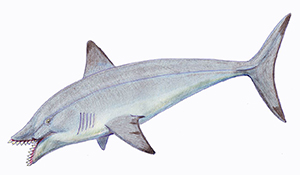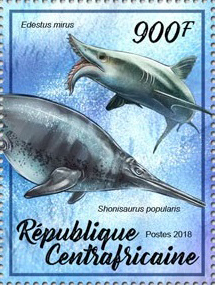Edestus mirus Hay, 1912

(Da: en.wikipedia.org)
Phylum: Chordata Haeckel, 1874
Subphylum: Vertebrata Cuvier, 1812
Classe: Chondrichthyes Huxley, 1880
Ordine: Eugeneodontida Zangerl, 1981
Famiglia: Edestidae Jaekel, 1899
Genere: Edestus Leidy, 1855
Descrizione
Come per tutti i suoi parenti stretti (Eugeneodontida), i denti di questo pesce crescevano in file ricurve; l'edesto, in particolare, possedeva una sola fila di denti per ogni mascella. In questo modo, la sua bocca finiva per assomigliare a un mostruoso paio di forbici a zig-zag. Il grado di curvatura delle file di denti, così come la taglia, erano differenti da specie a specie. Si presume che ognuna di queste specie fosse carnivora, a causa dei denti acuti e seghettati. Il modo in cui l'edesto catturava e mangiava le sue prede rimane puramente ipotetico, come anche il preciso aspetto dell'animale, a causa dell'assoluta mancanza di altri resti fossili. In ogni caso, resti più completi di animali relativamente simili (ad es. Fadenia) potrebbero indicare che l'aspetto dell'edesto assomigliasse vagamente a uno squalo dal corpo idrodinamico.
Diffusione
È un enigmatico pesce cartilagineo, forse affine agli olocefali (Holocephali). I suoi resti fossili sono costituiti essenzialmente da denti, spesso disposti in strane file ricurve, rinvenuti nei depositi del Carbonifero in gran parte del mondo.
Bibliografia
–A Source-book of Biological Names and Terms, Edward Jaeger (1944).
–Itano, Wayne M.; Houck, Karen J.; Lockley, Martin G. (August 2012). "Systematics and occurrences of Edestus (Chondrichthyes) worldwide and new occurrences from Colorado and Texas". Historical Biology. 24 (4): 397-410.
–Itano, Wayne M. A tale of two holotypes: Rediscovery of the type specimen of Edestus minor. The Geological Curator, 10 (1): 17 – 26.
–Tapanila, Leif; Pruitt, Jesse (2019-09-04). "Redefining species concepts for the Pennsylvanian scissor tooth shark, Edestus".
–Newton, E. T. (1904-02-01). "On the Occurrence of Edestus in the Coal-Measures of Britain". Quarterly Journal of the Geological Society. 60 (1-4): 1-9.
–Missuna A. Ueber eine neue Edestus-Art aus den Karbon-Ablagerungen der Umgebungen von Kolomna. [About a new Edestus species from the Carboniferous deposits of the surroundings of Kolomna] Bull Soc Impér Natural Moscou. 1908; 21:529-535.
–Tapanila, Leif; Pruitt, Jesse; Wilga, Cheryl D.; Pradel, Alan (2020). "Saws, Scissors, and Sharks: Late Paleozoic Experimentation with Symphyseal Dentition". The Anatomical Record. 303 (2): 363-376.
–Zangerl, R. (1981). Chondrichthyes I - Paleozoic Elasmobranchii. Handbook of Paleoichthyology. Stuttgart: Gustav Fischer Verlag. pp. I-iii, 1-115.
–Mutter, Raoul J.; Neuman, Andrew G. (2008-01-01). "New eugeneodontid sharks from the Lower Triassic Sulphur Mountain Formation of Western Canada". Geological Society, London, Special Publications. 295 (1): 9-41.
–Lebedev, O.A. (2009). "A new specimen of Helicoprion Karpinsky, 1899 from Kazakhstanian Cisurals and a new reconstruction of its tooth whorl position and function". Acta Zoologica. 90: 171-182.
–Itano, Wayne M. (2015). "An Abraded Tooth of Edestus (Chondrichthyes, Eugeneodontiformes): Evidence for a Unique Mode of Predation". Transactions of the Kansas Academy of Science. 118 (1 & 2): 1-9.

|
Data: 16/01/2018
Emissione: Animali preistorici marini Stato: Central African Republic Nota: Emesso in un foglietto di 4 v. diversi |
|---|